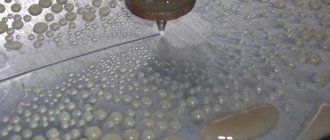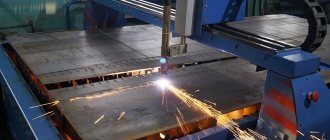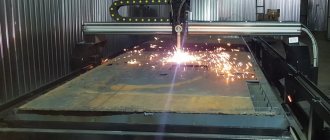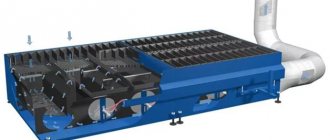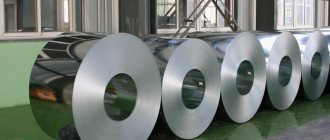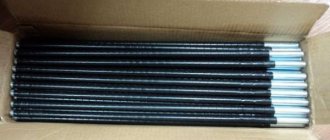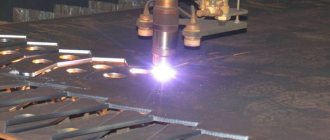This is one of the most modern technologies used not only in production, but also in small workshops. This method, with the correct selection of the type of equipment, is suitable for almost all metals and allows for conventional and artistic (curly) cutting. To achieve good results, you need to be familiar with the technologies and operating principles of this equipment.
Laser power for cutting metal blanks of various thicknesses
Thermal laser beam cutting makes it possible to achieve precision that almost completely eliminates the need for further processing. To increase efficiency, various gases are used: oxygen, carbon dioxide, nitrogen, hydrogen, helium, argon. The choice depends on the type of material, the thickness of the workpiece, and plans for subsequent processing. If cutting requires very high temperatures, oxygen is used. Only argon is suitable for working with zirconium or titanium.
Any laser equipment consists of:
- mechanism (system) providing energy supply;
- body generating the beam (solid, fiber, in the form of a mixture of gases);
- mirrors (resonator).
Solid-state laser equipment contains a diode and a rod made of ruby, neodymium or garnet. In fiber lasers, the beam-generating element (sometimes the resonator) is an optical fiber. Gas equipment uses gases or mixtures thereof. Power and scope of application depend entirely on the type of equipment:
- solid (for brass, copper, aluminum and its alloys) – 1-6 kW;
- gas – up to 20 kW;
- CO2 lasers (for any thin metal workpieces) – 600-8000 kW;
- gas-dynamic - from 150 kW.
For metal cutting, laser power is 450-500 W (except for non-ferrous metals, which require 1 kW or more). This method is most effective for workpieces whose thickness does not exceed 6 mm. At 20-40 mm, laser equipment is rarely used. For metal of large thickness, laser cutting (from 40 mm) is almost never used.
Dependence of power on workpiece thickness
| Type of metal | Workpiece thickness (mm) | Power, W) |
| Steel (alloy, carbon) | 1 | 100 |
| 0,5 | 250 | |
| 1,2 | 400 | |
| 2,2 | 850 | |
| Up to 40 | 5000 | |
| Stainless steel | 1 | 100 |
| 0,5 | 250 | |
| 1,3 | 400 | |
| 2,5 | 400 | |
| 3,2 | 400 | |
| 9 | 850 | |
| up to 25 | 5000 | |
| Brass | 12 | 5000 |
| Aluminum alloys | 12 | 5000 |
| Copper | 5 | 5000 |
| Titanium | 0,5 | 850 |
| 0,6 | 250 | |
| 1 | 600 |
Process [edit | edit code]
For laser cutting of metals, technological installations based on solid-state, fiber lasers and gas CO2 lasers operating in both continuous and pulse-periodic radiation modes are used. The industrial use of gas laser cutting is increasing every year, but this process cannot completely replace traditional methods of separating metals. Compared to many of the installations used in production, the cost of laser cutting equipment is still quite high, although recently there has been a tendency towards its reduction. In this regard, the laser cutting process becomes effective only if there is a justified and reasonable choice of the area of application, when the use of traditional methods is labor-intensive or completely impossible.
Laser diode for metal cutting
Laser diode for metal cutting is a semiconductor laser designed on the principle of a pn homostructure diode. The semiconductor is a wafer, the top layer of which creates the n-region (negative), the bottom layer creates the p-region (positive). The pn junction is relatively large and flat. The ends on the sides serve as resonators. A photon that moves perpendicularly is reflected from the ends several times, only then can it exit.
In the process of passing along the ends, new photons are created, the radiation intensifies, and beam generation begins. At the moment of release, it diverges greatly, so it is collected by lenses. Laser diodes for cutting metal with high power (10 micrometers) additionally emit carbon dioxide (CO2).
Important! Equipment of this type is characterized by increased productivity and relatively low cost.
Strengthening a homemade installation
To enhance the power and density of the beam, which is the main cutting element, you should prepare:
- 2 “conders” for 100 pF and mF;
- Resistance 2-5 ohms;
- 3 rechargeable batteries;
- Collimator.
The installation that you have already assembled can be strengthened to get enough power at home for any work with metal. When working on gain, remember that plugging your cutter directly into an outlet will be suicide for it, so you should make sure that the current first gets to the capacitors, and then goes to the batteries.
By adding resistors you can increase the power of your installation. To further increase the efficiency of your device, use a collimator that is mounted to focus the beam. This model is sold in any electrician store, and the cost ranges from 200 to 600 rubles, so it’s not difficult to buy it.
Then the assembly circuit is carried out in the same way as discussed above, only you need to wind an aluminum wire around the diode to remove static. After this, you have to measure the current strength, for which you take a multimeter. Both ends of the device are connected to the remaining diode and measured. Depending on your needs, you can adjust the readings from 300 mA to 500 mA.
Once the current calibration is completed, you can move on to aesthetically decorating your cutter. An old steel LED flashlight will do just fine for the case. It is compact and fits in your pocket. To prevent the lens from getting dirty, be sure to get a cover.
The finished cutter should be stored in a box or case. Dust or moisture should not get there, otherwise the device will be damaged.
CO2 laser (carbon dioxide) for cutting metal
Carbon dioxide lasers have characteristics that make them ideal for industrial cutting applications. The first is long infrared waves, ideal for heating. The second is high efficiency (from 30%). The use of carbon dioxide makes the cut smoother (compared to fiberglass equipment). The scope of application is expanding, investments are quickly paying off.
The disadvantage of a CO2 laser for cutting metal is the need for optical mirrors equipped with sapphire elements and gold. In addition, this type of equipment requires a high electrical discharge during the beamforming stage. For cutting metal (stainless steel, aluminum) 2 mm thick, a power of 160 W is sufficient if this type of laser is used. By increasing the power to 200 W, you can cut sheets 3 mm thick.
What can a 2.1 W laser do?
A 2.1 W laser is relatively low power for a laser. It is enough for effective cutting of paper, cardboard, plywood, dark acrylic up to 1–1.5 mm thick. Although this laser is more optimal for engraving, cutting is still possible at a relatively good speed. Cardboard and paper show virtually no charring at cutting speeds of 200–300 in the CNCC LaserAxe software.
Of course, the color of the material and the structure itself play a significant role. When we talk about efficient cutting, we mean a clean, uncharred cut. Again, I would like to remind you that many Chinese lasers do not have the declared power and very much do not correspond to the declared parameters.
Here is an example of what can be cut with a 2.1 W laser.
Laser wavelength for metal cutting
The absorption of a laser beam by a material is significantly affected by the quality of the wave: length and spectrum. The wavelength of a laser for cutting metal depends entirely on the type of material. If we consider a fiber laser, then one of its nodes creates a beam with a wavelength of 1 micron (millimicron). If a longer beam is required, a combiner is used to combine the beams of several modules. The performance of solid-state models differs little - the wavelength is also 1 micron. These types of lasers are ideal for cutting almost all types of metals (even noble ones). For cutting metal (stainless steel) 20 mm, the power of the fiber laser is from 2 kW.
In carbon dioxide lasers, the wavelength reaches 10.6 microns, which creates a higher density on the treated surface. This type of equipment is used for cutting glass, wood, fiberglass, demonstrating high cutting quality even with large thicknesses.
When choosing equipment, it is not enough to study the technical characteristics: type of emitter, power, wavelength, accuracy and quality of cut. It is important to accurately determine the requirements of a particular production. The laser power for cutting metal (for example, stainless steel) 3 mm thick cannot be lower than 500 W. Otherwise, productivity will decrease and the material will overheat. At first glance, a CO2 laser of the required power may be suitable. But in this case it is necessary to take into account the wavelength, which is not entirely suitable for metal workpieces.
Advice! In order not to make a mistake, before purchasing you need to accurately calculate everything or consult with a qualified specialist.
Benefits [ edit | edit code]
Laser cutting is carried out by burning through sheet metal with a laser beam. This technology has a number of obvious advantages over many other cutting methods:
- The absence of mechanical contact allows the processing of fragile and easily deformable materials;
- Materials made of hard alloys can be processed;
- High-speed cutting of thin sheet steel is possible;
- When producing small batches of products, it is more expedient to laser cut the material than to make expensive molds or casting molds for this;
- To automatically cut the material, it is enough to prepare a drawing file in any drawing program and transfer the file to the computer of the installation, which will withstand errors of very small quantities.
Optimal power and operating principle
Most beginners do not understand how the device functions and what needs to be done. To understand the principle of operation, just look at how engraving or cutting is done at production sites.
The first thing the operator does is sit down at the computer and create a certain form in the appropriate graphic editor. In the second paragraph, he describes all passes of the laser beam. After which the information is transferred to the machine, and the process begins.
To make a cut, you just need to specify the thickness of the material and start the machine. All operations occur automatically; a person only needs to ensure that the work is done correctly.
Most enterprises or home workshops try to buy small-format machines. They are mainly purchased for working with plywood and engraving on stainless steel. The emitter power is 40 W, for such purposes this value is sufficient. But devices with 60-80 W and higher are also sold. They are more focused on the professional field, where it is necessary to carry out cutting operations with various materials every day.
Protecting the fiber laser from reflected beams
It is important to understand that certain metals pose a certain danger to the laser with which they are processed. This is due to their characteristic significant reflection coefficients.
The advantage of IPG products is that they are designed to protect fiber emitters from reflected rays.
Lasers of this brand are offered in two protection options:
- LK - have a passive system, the sensors of which catch reflections and inform the operator about the identified danger;
- LS is an active system. Allows you to level out identified dangerous reflections. You don't have to interrupt your work for this.
Machines of the second type are the best solution for processing workpieces made of materials such as aluminum, brass, mirror stainless steel, and copper.
Another indisputable advantage of IPG products is a better Gaussian beam, which provides a more stable cut. However, this does not affect the thickness of the workpieces being cut and the cutting speed.
HOORAY! The machine has arrived!
Just now they called me from Zheldorekspedition (transport company) and said that my machine had arrived. Delivery from China to Orenburg took about a month and a half. As the seller states, he bears all shipping costs. I just arrived at the pick-up point, signed and picked up the machine. I didn’t have to pay a penny extra, either for customs duties or for delivery. Pleasant pleasantness). The weight of the parcel is 84 kg, it is too heavy to be loaded/unloaded by one person. But it fit right into the car “bullet to bullet.”
Rating of the best models in the mid-price segment
TS 1060 (100W, W4 RECI)
A reliable device designed for high-quality cutting and engraving of any materials except metal. The device is perfect for the advertising industry, where it is necessary to apply logos to acrylic, plastic, paper, etc.
The control system is highly reliable and durable. The interface will be clear even to an inexperienced user. In addition, the product is highly accurate thanks to high-quality guides that move the laser head without delay. For greater convenience, a through-type table is used, thanks to which a person can cut long products.
The laser tube power is 80 W, with a service life of 10,000 hours. Control is carried out via a built-in LCD display, which has corresponding keys. The ability to install a USB drive is supported.
Sold at a price: from 306,000 rubles.
laser cutting machine TS 1060 (100W, W4 RECI)
Advantages:
- Strength;
- Convenient operation;
- High accuracy;
- Efficiency;
- Performance;
- Emitter service life;
- Optimal cost.
Flaws:
- Not detected.
Bodor BCL0605MU
A small device designed for professional cutting and engraving of non-metallic products. Thanks to its compact size, the device can be installed almost anywhere.
The design has special holes that remove unpleasant odors. To make it easier to monitor the condition of the workpiece, a special window is used. The table is made of stainless steel; a special screw is used to lift it.
A feature of the electric motor is low noise and vibration. This ensures high accuracy and productivity.
Sold at a price: from 362,000 rubles.
laser cutting machine Bodor BCL0605MU
Advantages:
- High service life;
- High-quality processor;
- Accuracy;
- Performance;
- Design;
- Wi-Fi support.
Flaws:
- Not found.
GM-1610 Reci W4, Chiller CW500
A reliable option that allows you to process stone. A design feature is the ability to quickly disassemble the housing for maintenance. There is a special unit to control the device.
Laser power – 80 W. The engraving speed is 700 mm per second. The maximum thickness of material for cutting is 20 mm. It is recommended to use the device at temperatures between 10 and 45 degrees. Water cooling is used to cool the laser. Powered by 220 V mains.
The average cost is 450,000 rubles.
laser cutting machine GM-1610 Reci W4, Chiller CW500
Advantages:
- Clear software;
- Easy maintenance;
- Efficiency;
- Accuracy;
- The service life of the emitter is 5000 hours.
Flaws:
- Not detected.
Engraving machine brands
We present equipment from the most famous European manufacturers.
SHARPMARK FIBER series engravers from SHARPLASE
SHARPMARK FIBER laser fiber machines perform a wide range of production operations:
- engraving, marking and cutting of metal, plastic, stone, leather, various polymers;
- engraving and marking of products and parts used in industry;
- jewelry engraving;
- engraving of souvenirs, gifts, corporate identity items;
- production of seals and stamps;
- 3D engraving;
- application of photorealistic images and much more.
These machines consist of 3 modules: a laser emitter, a marking module and a work table. The equipment is lightweight and compact in size. If necessary, engravers can be equipped with additional equipment.
The engravers are equipped with IPG Photonics emitters. The work stand is equipped with a Z-axis movement screw with a frequent thread pitch. This makes it possible to set the focal length with an accuracy of 0.01 mm. Marking accuracy is up to 5 microns, repeatability is up to 2.
Software features:
- laser machine control;
- monitoring and testing of laser equipment in real time,
- import of graphic information in formats: *.BMP, *.JPG, *.DFX, *.STL;
- support for all TRUE TYPE fonts;
- support for vector and raster operating modes;
- working with text and graphic images;
- working with three-dimensional graphics, setting the depth of each level;
- rotation, reflection, scaling, grouping of images;
The machines are equipped with a light identification system that informs the user about the completion of work, the occurrence of errors and malfunctions.
| SharpMark engraver models | Working field, mm | Marking speed | Fiber emitter | Power | Lens | Scanning system | Additional functions |
| Fiber Standard and Fiber Standard VAR | 110x110 | 7,000 mm/s | Pulse/variable pulse (VAR) | 20, 30, 50 W | F 163 mm | 2-axis high-speed IMD scanner (USA) | |
| Fiber Optima and Fiber Optima VAR | 180x180 | 10,000 mm/s | Pulse/variable pulse (VAR) | 20, 30, 50 W | F 254 mm | 2-axis galvanometric scanner IMD (USA) | “High Contrast” option Deep 3D engraving Engraving and marking of large items |
| Fiber PRO and Fiber VAR PRO | 110x110 | 10,000 mm/s | Pulse/Variable Pulse (VAR) | 20, 30, 50 W | F 163 mm provides ultra-precise 3D focusing manufacturer Lambda (USA) | High-precision scanning mirror system Cambridge Technology (USA) | “High Contrast” option Deep 3D engraving Engraving of conical products Shaped cutting Built-in video camera Illumination of the work area |
| Fiber PRO XYZ and Fiber PRO XYZ VAR | 600x400 | 10,000 mm/s | Pulse/variable pulse (VAR) | 20, 30, 50 W | F 160 mm Lambda (USA) | Cambridge Technology (USA) | Processing of non-standard products Automatic duplication of objects Deep 3D engraving Cutting thin metals “High Contrast” option XYZ axis control controller Illumination of the work area Built-in video camera |
TruMark 5000 Series laser machines from TRUMPH
TruMark 5000 Series fiber lasers are versatile machines for marking and other applications.
Functionality of TruMark lasers:
- high-speed application of text markings using various methods: - changing surface color; — deep engraving; - change in color of the material; — removing layers from the surface; — foaming – used for applying raised inscriptions;
- surface structuring;
- laser cleaning of surfaces.
Lasers are designed to work with metals, synthetic materials, glass, silicon, ceramics and organic materials.
TruMark machines combine high power, high pulse frequencies and variable pulse durations to deliver excellent machine performance. High pulse frequency is a feature of TruMark lasers that ensures high speed operation. The pulse duration can be adjusted according to the type of material being processed and the production task. The power can be monitored using the built-in measurement system and adjusted if necessary. Quick adjustment of the focus position is carried out by changing the diameter of the laser beam. The focus adjustment system is controlled via the TruTops Mark software and allows stepped parts to be marked in one stroke without moving them mechanically.
TruTops Mark software features:
- inscription function;
- creating and organizing graphic objects in a CAD editor;
- the ability to create programs that control the full cycle of inscription application, thanks to the programming of QuickFlow algorithms;
- saving optimized parameters in a database for reuse;
- a diagnostic tool used to visualize and analyze measurements obtained by sensors;
- control of laser parameters and interfaces.
The machines have a modular design, modules are quickly connected via plug connections.
INFIBER laser marking and engraving systems from Oltek Photonics
INFIBER are high-performance fiber laser engravers and markers designed for marking various types of materials. These machines are in demand in various industries: electronic instrument making, production of household appliances, mechanical engineering, high-precision metalworking, production of medical instruments.
INFIBER laser markers allow you to apply logos, dates, serial numbers, linear and two-dimensional barcodes, etc.
Advantages of INFIBER models:
- ultra-compact aluminum marking head with protection class IP 64;
- built-in programmable “Green Spot” controller, providing instant visual display of the signal on the marked surface;
- support for innovative Lighter Marvis software;
- built-in SLO (Safe Laser Off) mode with a double relay for blocking laser power, as well as maintaining laser control mode with double feedback;
- silent operations;
- built-in communication protocols: Ethernet TCP/IP - Ethernet IP and ProFinet (1Q2019).
The influence of machine idle speed on laser cutting speed
The device is brought to the starting point of cutting according to the program at a speed significantly higher than during cutting. It is called no-load speed and is used to reduce the total technological time for processing a part. The range of changes in idle speeds varies from 60 to 200 m/min. Naturally, this pace is not intended for cutting. The cutting speed is several times lower than the idle movement and depends on the power of the laser emitter.
High idle speed modes are necessary when the length of work tables is more than 3 m, as well as in the case when most of the movement during the manufacturing process of a part must be carried out in the idle mode without processing, for example, when making holes in the corners of a large sheet of metal.
Criterias of choice
When looking for a good machine, you should know what parameters you pay attention to first. It is also important to determine for what purpose the equipment is purchased; this will help reduce time costs by 2 times.
- The first thing that is taken into account is the material used to make the emitter. To do this, you need to know the companies that produce these products. Basically, you should only trust well-known brands, as you can find more information about them.
- To know the performance of a machine, attention is paid to the technical characteristics of the mechanical components. It is better to buy products with a durable body and easy maintenance.
- Availability of a factory warranty, as well as the quality of the products included in the kit.
- Ease of use.
- Ability to work with multiple workpieces.
- How long can a laser be used in one turn?
Most of the companies that produce such equipment are located in China, the USA and Austria. At the same time, the duration of the warranty is different for everyone; if the maximum period for Chinese devices is up to 2 years, then for Austrian devices the figure is twice as long.

